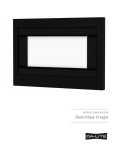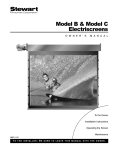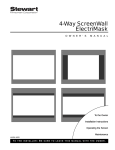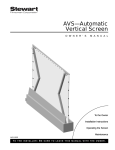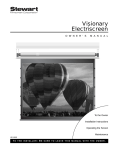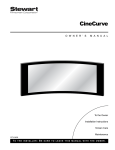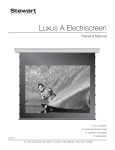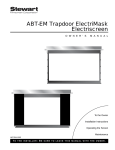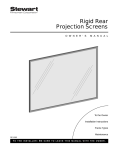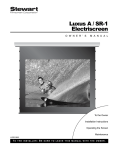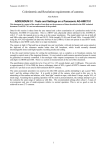Download Cine V Owner Manual - Stewart Filmscreen Corporation
Transcript
Stewart Filmscreen Corporation Cine V Assembly Instructions. CineV Owner’s Manual Contents To the Owner…………………………………………….1 Preparing the Installation………………………………..2 Frame Assembly and Wall Mount………………………3 Attaching the Screen to the Frame………………………4 Operating the Cine V…………………………………….5 Screen Care and Cleaning……………………………….6 Product Warranty………………………………………..7 Troubleshooting…………………………………………8 TO THE OWNER Congratulations on your purchase of one of the finest optical viewing screens available anywhere in the world. Please take a moment to review this manual, it will help ensure you many years of trouble-free service from your new Stewart Filmscreen product. About the CineV Your CineV Features a 2.35:1 aspect ratio to allow full enjoyment of images in this dramatic, super-widescreen format produced by a projector with an anamorphic lens. To accommodate other aspect ratios, the CineV feature a masking system. The screen maintains a constant vertical height, while the electronically controlled masking panels drop down at the left and the right of the screen to create a perfect HDTV image area. A side trim cover is available as an option. The frame acts as a projection overscan border. The VeLux finish is designed to absorb any light spill. VICS The CineV uses the Stewart Filmscreen VICS ( Video Interface Control System) for operation of the masking motors or desired aspect ratios. VICS (220 VOLTS VICS 110 VOLTS Preparing the Installation Preparation Specifications regarding the individual screen dimensions, weight, mounting type, and controls are provided by the factory when the unit is ordered. Before beginning the installation: ♦ Check the specifications for the frame and the mounting to be used. ♦ Prepare for electrical access ♦ Check the size and weight of the screen to be installed so that you can plan for the number of people required for the mounting procedure. You need at least two people to mount the frame and attach the screen. You will need: ♦ Gloves, for handling the screen. ♦ Ladders for the personnel supporting the screen during the mounting process, as needed. ♦ A level. ♦ Fasteners appropriate for the surface on which the screen is being mounted. ♦ Drills for making holes to attach brackets to the mounting surface, as needed. ♦ Tools for tightening fasteners, including 7/16” and ½” hex head wrench. Note: Bolts and other fasteners for the screen are standard gauge and sizes used in the U.S., regardless of where they will be installed. For this reason, the sizes are expressed in inches rather than metric measurements. Unpacking Be sure to unpack carefully in a clean area. Use special care when handling the screen so that it does not become soiled or damaged. Inspect contents of this container immediately upon receipt. All damage claims must be made within 24 hours after receipt of goods. CineV Components Figure 1. CineV components, rear view This section identifies the principal components of the CineV. The unit is shipped in several different sections: the top, bottom and side member sections, top section with a motor assembly on the outside, plus mounting brackets. Side view Motors. Masking panels. Mounting brackets. Figure 2. CineV components, front view Front bezel or face shield. Frame Assembly and Wall Mount Professional mounting techniques should be used. Stewart Filmscreen Corporation cannot be liable for substandard or faulty installations. This section describes assembly and mounting of the CineV frame. 1. Assemble the frame by fitting together the slip joints of the side sections. The sections are number matched from one to four. Secure the sections using the supplied ¼-20 X 3/4 hex head bolt. 2. If necessary , attach the center wall mount to the back of frame. 3. Mount the frame to the wall. If possible, attach to wall studs. Alternately, use hollow wall anchors or molly bolts appropriate for the weight of the screen and frame assembly. 4. Make sure the frame is level and plumb. 5. Ensure that after you attach the screen, you can access the motor and cables for attachment to the VICS controller. 6. When you are ready to connect the motor cables to the VICS, refer to the VICS manual. 3 SLIP JOINT REAR VIEW 3 2 4 2 4 1 1 ATTACHING THE SCREEN TO THE FRAME This section provides instructions for attaching the screen to the frame. Caution ♦ Be sure that your hands and clothing are clean. Use of gloves is recommended. Be careful not to touch or scratch the image surface with fingernails. ♦ Do not use any tools to fasten the screen to the frame. ♦ Do not fold or crease the screen. You will need at least two people, one to support the screen, and one to snap the screen in place. The viewing side of the projection screen is rolled to the inside to protect the optical coating. The screen is rolled lengthwise, with protective paper rolled in with the screen. The screen fabric attaches to the frame with snap fasteners. 1. Remove the screen from the cardboard shipping tube. 2. Look at the frame and locate the snaps. 3. While supporting the screen roll, snap the screen into the frame starting at the top left. Gently allow the screen to stretch onto the snaps. Refer to Figures and Attach the snaps on the top corners and top horizontal section first, unrolling the screen as you go. Attach remaining snaps. Operating the CineV CineV operation is controlled by a Stewart Filmscreen VICS. Refer to the VICS manual for details. You can use either a hand-held remote control or a wall mounted switch to operate the masks. Caution Keep objects and fingers out of the way of the mask when they are in motion. Screen Care and Cleaning General Maintenance The surface of our screen is delicate. Special attention to these instructions should be followed when cleaning. BRUSH ♦A draftsman-style brush may be used to lightly whisk away any loose dirt or dust particles. Stewart Filmscreen may supply a screen cleaning kit that contains the proper type of brush. Contact the dealer if you would like to obtain an additional cleaning kit. ♦ For tougher spots, use a solution of mild detergent and water. Rub lightly using a sponge. Blot with a damp sponge to absorb excess water. Residual water marks will evaporate within a few minutes. Do not use any other cleaning material on the screen. Contact the factory if you have any questions about removing difficult spots. SFC CLEANING KIT Caution Do not use chemicals or liquid to clean the fabric. VeLux Covering ♦Use a lint roller to remove particles from the VeLux material. ♦A brush can be used to comb (lift) the nap off the VeLux material to help eliminate depression marks Replacement Parts and Service LINT ROLLER No user-serviceable parts are contained within the unit. Contact your dealer or the factory if you require part replacement or service. Troubleshooting With reasonable care, you may expect many years of trouble free use of your Stewart projection screen. Refer to following guidelines if you encounter a difficulty in the operation of your Stewart screen. Problems related to electrical or motor function may require a qualified service or electrician. Should you have a problem that is not addressed here, call the Stewart Filmscreen Corporation. 800 762-4999 Problem Description Probable Cause Action to Take Dirt, finger prints, marks, etc. on screen surface or masking panels. Improper handling of screen. Brush off or use a mild detergent solution with clean rag or cotton swab (screen only). Motor chatters when power is activated. Can be caused by voltage drop, bad connections, or a defective switch. Have an electrician or qualified service person check all hook-ups including all outboard wiring. When retracing the masks, grinding noise occurs. Drop in Voltage Motor requires full voltage. Have an electrician or qualified service person check available voltage.









